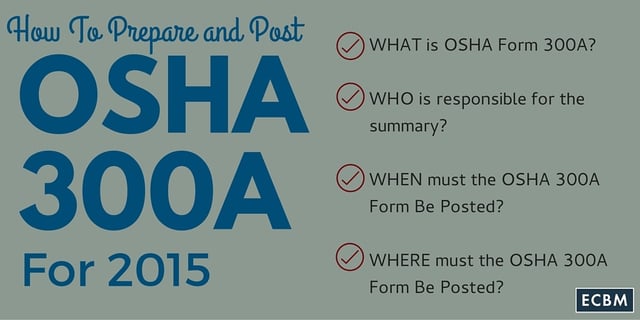
Employers must fill out the Log and the Incident Report only if a recordable, work-related injury or illness has occurred. However, the Summary must be filled out and posted annually even if no recordable, work-related injuries or illnesses occurred during the year.
General Background Information
Under OSHA’s recordkeeping regulation at 29 CFR 1904, certain covered employers are required to prepare and maintain records of serious occupational injuries and illnesses using the OSHA 300 Log. This information is used in evaluating the safety of a workplace, understanding industry hazards, and implementing protections to reduce or eliminate hazards to workers.
Covered employers include those with more than 10 employees at any given time during the year. OSHA partially exempts a number of establishments in certain low-hazard industries from injury and illness recordkeeping requirements, unless they are asked in writing to do so by OSHA, the Bureau of Labor Statistics (BLS), or a state agency operating under the authority of OSHA or the BLS. All employers, including those partially exempted by reason of company size or industry classification, must report to OSHA any workplace incident that results in a fatality, in-patient hospitalization, amputation, or loss of an eye.
The injury and illness recordkeeping forms are:
- The Log of Work-Related Injuries and Illnesses (OSHA Form 300)
- The Summary of Work-Related Injuries and Illnesses (OSHA Form 300A)
- The Injury and Illness Incident Report (OSHA Form 301)
READ MORE: What Is OSHA And Why Is It Important For Your Business?
What Is OSHA Form 300A?
OSHA Form 300A is the Summary of Work-Related Injuries and Illnesses. The annual summary is a list of injuries and illnesses that were recorded on the OSHA 300 Log during the previous calendar year. At the end of each calendar year, the employer must create, certify, and post an annual summary of injuries and illnesses recorded on the OSHA 300 Log.
Employers must fill out the Log and the Incident Report only if a recordable, work-related injury or illness has occurred. However, the Summary must be filled out and posted annually even if no recordable, work-related injuries or illnesses occurred during the year.
Who Is Responsible for the Summary?
A company executive must certify that he or she has examined the OSHA 300 Log and that he or she reasonably believes, based on his or her knowledge of the process by which the information was recorded, that the annual summary is correct and complete. The company executive who certifies the Log must be:
- An owner of the company (only if the company is a sole proprietorship or partnership);
- An officer of the corporation;
- The highest-ranking company official working at the establishment; or
- The immediate supervisor of the highest-ranking company official working at the establishment.
When Must the OSHA 300A Form Be Posted?
The summary must be posted no later than February 1 of the year following the year covered by the records. The form must be kept in place until April 30.
Where Must the OSHA 300A Form Be Posted?
A copy of the annual summary must be posted in a conspicuous place or places where notices to employees are customarily posted. Employers must ensure that the posted annual summary is not altered, defaced, or covered by other material.
January is the time to review workplace injuries and illnesses from the previous year for compliance and accuracy. Remember, when checking your OSHA 300 Log for compliance, that only incidents that meet one or more of the general recording criteria should be listed on the log. If the incident required days away from work, restricted work or transfer to another job, make sure that you have counted and recorded the correct number of calendar days and have entered them on the log. When a work-related injury carries over into the next calendar year, you will need to ‘estimate’ the total number of days away, and/or restricted work days and put that number on your OSHA 300 log and calculate totals on the summary report.
Still have questions?
Contact Barbara Taylor at 888-313-3226 ext. 1320 or send an email to: btaylor@ecbm.com if you have any questions regarding your OSHA logs or summary report.
Wishing you a happy, healthy and safe New Year 2016.
Barbara Taylor


